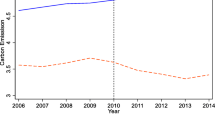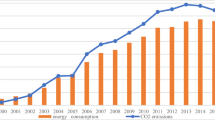Abstract
At present, China’s carbon emissions rank first in the world, which not only brings huge challenges to the sustainable development of China’s economy, but also brings more pressure from public opinion in the international community. With the outward migration of China’s manufacturing industries to Southeast Asia, the carbon emissions embodied in trade has also been transferred. These trends provide a good opportunity to analyze the characteristics of transnational industrial restructuring and spatial structure transformation of carbon emissions between China and Southeast Asian countries. In 2020, ASEAN has become China’s largest trading partner, and Thailand, due to its unique industrial structure and investment environment, will surely become one of the main ASEAN countries to undertake the transfer of China’s manufacturing industry. Over the years, the shift of carbon emissions by the continuous transfer of a large number of basic manufacturing industries from China to Thailand promoted the release of China’s carbon emission pressure. In this article, on the basis of the data of import and export commodities between China and Thailand from 2012 to 2017, the input-output model is carried out to analyze the energy consumption of China’s various industries, and three periods, namely 2012, 2015, and 2017, are used to be key periods to calculate the embodied carbon of China’s manufacturing migration and Sino-Thailand trade. The empirical results show that the transfer of China’s manufacturing to Thailand from 2012 to 2017 has continued to rise. The transfer of Chinese manufacturing to Thailand is positively correlated with the carbon emissions of trade between the two countries, which has promoted the relief of China’s pressure on energy conservation and emission reduction. Therefore, government departments should formulate differentiated and stable domestic manufacturing policies, spend on the development of advanced manufacturing industries with low energy consumption and high technology density, and encourage the relocation of industries with low technology density and high-carbon emissions to effectively reduce environmental pressure in China.

Similar content being viewed by others
Data availability
In this article, used to gnap database, on the basis of the data of import and export commodities between China and Thailand from 2012 to 2017, the input-output model is carried out to analyze the energy consumption of China’s various industries, and three periods, namely 2012, 2015, and 2017, are used to be key periods to calculate the embodied carbon of China’s manufacturing migration and Sino-Thailand trade.
References
Cong, Liu; Kang Li; Wang Li (2017) Analysis of interprovincial trade embodied carbon emissions in Bei**g-Tian**-Hebei and surrounding provinces: based on constructed MRIO Model. Taylor J. 71–79
Rosa Duarte; Vicente Pinilla; Ana Serrano, (2018) Factors Driving Leakage Carbon in International Trade: A Multiregional Input-Output Gravity Model. Taylor J 545–566
Fan X, Wu S, Li S (2019) Spatial-temporal analysis of carbon emissions embodied in interprovincial trade and optimization strategies: a case study of Hebei, China [J]. Energy 185:1235–1249
Chen Hongfei. (2018) Study on the carbon implicit in China-ASEAN bilateral trade based on the MRIO model. East China Normal Univ. 05
Jiajia L, Chandio AA, Yucong L (2020) Trade impacts on embodied carbon emissions—evidence from the bilateral trade between China and Germany. Int J Environ Res Public Health 17(14):5076
Jiefeng L (2017) Measurement of China’s manufacturing trade implicit carbon based on the MRIO model. Stat Dec Making 19:157–160
Liu Q, Long Y, Wang C, Wang Z, Wang Q, Guan D (2019) Drivers of Provincial So 2 emissions in China-based on multi-regional inject-output analysis. J Clean Prod 238:117893
Li Lutong. (2015) Transference of carbon emissions implied in Sino-US bilateral trade in goods. North China Electric Power University 2015–03
Nan C, Xuemin L, Nagatabe Y (2016) The influence factors of industrial transfer and trade carbon implicit between China and Japan: a research perspective based on vertical specialization. Sci Technol Manag Res 15:236–241
Tao W, Shuijun P. (2017) A study on energy and carbon emissions transfer in international trade based on multi-regional input-output model. Resources Sci.(01): 94–104
Wang Q, Zhou Y (2019) Imbalance of carbon emissions embodied in the US-Japan trade: temporal change and driving factors [J]. J Clean Prod 237:117780
**e J, Peishan J. (2014) Estimation and decomposition of implied energy consumption in China's import and export trade based on input-output model. Econ Q (04):1365–1392
**e H, ** FG (2017) Inter-regional input-output analysis of Northeast China based on the MRIO Model. Harbin Univ Harbin Instit Technol 11:347–350
Yaxiong Z, Kun Z, Wang F (2010) Methods, development and application of inter-country input-output model. Stat Res 11:9–16
Yong L (2018) Location selection analysis of China's industrial transfer to ASEAN countries. Shanghai Acad Soc Sci 66
Zhang X, Yi L, Yang C. (2019) Location selection of labor-intensive industries transfer to countries along the "One Belt and One Road": A perspective of industrial undertaking capacity and factor constraints. J Soc Sci Jilin Univ. (01):111–122+222
Zhiquan Q, Yang L (2016) The impact of vertical division of labor in East Asia on carbon embedded in China’s foreign trade: an inter-temporal comparison based on the MIRIO-SDA method. Resources Sci 09:1801–1809
Yuan Huan (2019) The measurement of embodied carbon in China’s manufacturing trade and its influencing factors. Chongqing Technology and Business University
Funding
This paper is supported by the science and technology research project of Hubei Provincial Department of education “Research on the impact mechanism of energy consumption and export trade in Hubei Province” (No. B2019305).
Author information
Authors and Affiliations
Contributions
WU and CUI developed the idea of the study; MEI, XU, and ZHANG participated in its design and coordination and helped to draft the manuscript. WU and CUI contributed to the acquisition and interpretation of data. WU and CUI provided critical review and substantially revised the manuscript. All authors read and approved the final manuscript.
Corresponding author
Ethics declarations
This study was purely registry based, as no human participants were recruited or included in experiments.
Ethics approval
Ethics approval is not required for this paper.
Consent to participate
Not applicable.
Consent for publication
Not applicable.
Competing interests
The authors declare that they have no competing interests.
Additional information
Responsible Editor: Nicholas Apergis
Publisher’s note
Springer Nature remains neutral with regard to jurisdictional claims in published maps and institutional affiliations.
Rights and permissions
About this article
Cite this article
Wu, J., Cui, C., Mei, X. et al. Migration of manufacturing industries and transfer of carbon emissions embodied in trade: empirical evidence from China and Thailand. Environ Sci Pollut Res 30, 25037–25049 (2023). https://doi.org/10.1007/s11356-021-14674-z
Received:
Accepted:
Published:
Issue Date:
DOI: https://doi.org/10.1007/s11356-021-14674-z




